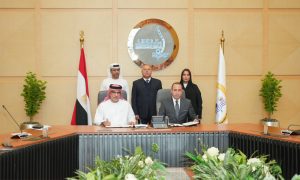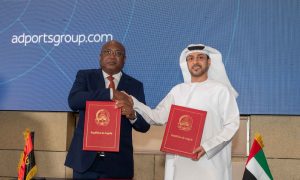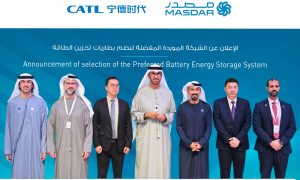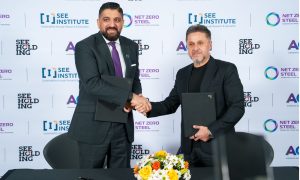Andrea Scotti: From Lego to Louvre Abu Dhabi engineering feats
BuroHappold director on how his early interests led to more complex projects

As a child, Andrea Scotti was always in awe of bridges. Sitting in a coffee shop in Dubai, Scotti fondly recalls building bridges with Lego as he was growing up in Italy, admitting that this enthusiasm was probably one of the motivating factors behind his choice of career.
“Interestingly, I’ve always been fascinated by bridges, although I have never designed a bridge. My father is a civil engineer and he does civil structures. So I guess I always had a leaning towards structural engineering or civil engineering. And I really, really, really wanted to do bridges,” he says.
Scotti has come a long way since then. He is now Abu Dhabi director of BuroHappold Engineering, overseeing the operations of the engineering firm’s office in the capital.
“I studied in Italy until I was 24, so I did my five years of university at Polytechnic Milan, and after that I went to do a master’s at MIT in Boston, Massachusetts,” he recounts. Going abroad to study at MIT was “a life-changing experience”, opening up new horizons. Soon after, Scotti, who has master’s degrees in Civil and Structural Engineering as well as High Performance Structures, went to work for BuroHappold in the UK as a structural engineer.
“When I applied for BuroHappold, I was accepted to the lightweight structures team. Now I’m actually happy that I haven’t been involved with bridges. Then I moved to the UAE, to Dubai to work. Then a year and a half ago, I moved to Abu Dhabi to be the office director. Now I cover the business aspect a well as being involved with the discipline.”
A structural engineer’s role
BuroHappold Engineering, a UK-based firm, provides engineering consultancy, design, and project management services. Structural engineering is one of its areas of expertise, a field that Scotti himself specialises in. But how would he define it, in basic terms?
“In its most basic terms, it’s essentially making stuff stand up,” he explains. “But that’s as basic as it gets. The more interesting bit is how do you make it stand up while doing other things [like] expressing an architectural image, or being environmentally friendly or respecting a budget. That’s what good structural engineers try to do.”
A typical day in his life as a structural engineer is “quite a lot of work”, he says with a smile. “I remember I made my life challenging because I wanted to be involved in all the exciting projects in the office. I very much liked working on geometry problems. So how do you set the rules for defining your geometry in your structural model, that’s what I spent most of the time with. And it was quite exciting.”
One of BuroHappold’s most notable projects in the UAE is the upcoming Louvre Abu Dhabi museum at Abu Dhabi’s Saadiyat Island. “We are the engineers of the Louvre. As a company, we developed the design of the Louvre from its inception to construction,” Scotti says. “Additionally, we have now a site team of approximately 35 people based in Abu Dhabi, following the project. The design has been carried out mostly by our Bath office, where we have the special structures team.”
Commenting on the technical challenges of the project, Scotti points out that the iconic dome, while an engineering feat, wasn’t the only difficult part. “Designing a 180m spanning dome with only four supports is a challenge in itself.” The Rain of Light effect, created by an arrangement of geometric openings in the dome’s structure, is also no mean feat, he notes.
“But what’s probably the most challenging bit about the Louvre design is what you don’t see, it’s the basement. It’s underwater,” he says. “The Louvre is on an island and it’s going to be surrounded by water. So what happens is all the storage areas of all the exhibits is underwater. So you have to store something as valuable as the Mona Lisa under 10 metres of water. That’s the clever bit. That’s what’s very difficult, and the amount of thinking, detailing and discussing with the contractors, that was quite a challenge from a design point of view.”
But working on designs and projects that are difficult to build and bringing them to life is “the destiny of engineering”, Scotti says.
“We’re destined to make architectural things work. Our role is one of supporting and guiding the architectural ideas. To understand what [it] is of the architectural concept that resonates with the client and support the architect in developing that resonating idea in a more sensible way or in a more realistic way. In general, it’s interesting to see that what makes sense physically is what actually translates into good architecture.”
Adding value
While complex structures no doubt come with their fair share of technical obstacles to overcome, what are the overall challenges for structural engineers?
“At this stage of my career, I would say it is creating a tangible value,” Scotti notes, pointing out that advances in technology have ensured that “it’s getting easier and easier to do structural engineering”
“But having someone to understand that some types or that some structural engineers are able to add greater value to the final product or even to the overall process… that’s difficult. BuroHappold differentiate ourselves from the day-to-day making things stand up to actually making things stand up and adding value to it. That’s what’s exciting, that’s what’s difficult to convey.”
An example of how structural engineers can add value to a project is BuroHappold’s work on the Louvre Abu Dhabi’s basement, mentioned earlier. “Our team worked very, very closely with the worldwide specialists on waterproofing, on injection materials, on detailing, on modellingbecause it’s a large footprint. Also, the way you model it affects the way you design it.”
Additionally, there can also be challenges working with the other players involved in a project. “Everyone wants something slightly different. Everyone is working on the same goal, but maybe the architect is slightly more worried about aesthetics, the engineer about functionality, the contractor about time, the client about cost,” Scotti points out.
“That’s the normal challenges of any project. Although you’re working with the same common goal, there’s likely a different point of view on that goal. So marrying all those points of views, it can sometimes be challenging.”
He also stresses the importance of good interpersonal relationships in the industry. “Everything we do in our industry is done by people. So it’s very much to do with how well you relate to people. If that’s missing, the personal touch, it’s very difficult to work with anyone.”
But how easy is it to find the right people for the job in this region? Scotti admits that while it’s possible to find skilled talent in the region, he hasn’t come across structural engineers who are UAE nationals.
“I don’t think we’ve come across a local structural engineer in the past few years. In terms of the Middle East, I think yes, there is quite a bit going on and as the country develops, [I’m sure] that there will be more.”
Scotti himself has worked with budding engineers in the country, with a teaching stint for about a year and a half at the American University in Dubai. “To me, it was very much an opportunity, after several years of structural engineering, to going back to explaining to someone who essentially doesn’t know what structural engineering is,” he recollects.
“It’s fun. I’d love to do it again. Having to deal with younger people or with students keeps you fresh. It forces you to think in a slightly different way.”
BuroHappold is also tapping into young talent in the country by hiring one or two graduates every year from the American University of Sharjah, he reveals.
How the market has evolved
With the constant stream of construction activity in the UAE as the market picks up after the crisis, one wonders how the industry has evolved over the past few years. When asked what needs to change for the construction sector to improve, Scotti is candid in his response.
“Five years ago, I would have told you people’s attitude. Because I think there was a clear gap on average in people’s attitude towards delivering a good product. There was only delivering a product.
“I would say things are changing. Clients are expecting more and are readier or are prepared to understand that accepting more means more time, or it means more fee, or it means more attention to details,” he says, adding that he is positive about the developments in the industry.
“Now, I think people are approaching the built environment more wisely. If anything, it would be great to see the pace of change slightly faster. But there is definitely change happening, and it’s positive.”
The most rewarding part of being a structural engineer is applying engineering solutions to help clients bring projects to life, he says. “At the moment, what I like about my job is being able to apply engineering thinking to several different problems. Apart from structural engineering, what’s interesting is supporting clients in developing their ideas into well thought-through and financially viable developments. It is absolutely exciting. It’s what we’re trying to do and what we’re pushing quite a lot.
“In terms of the amount of development that is happening, it needs quite a lot of support. And we’re happy to be here and support it.”
LOUVRE ABU DHABI: HISTORY IN THE MAKING
In December last year, the Tourism Development & Investment Company (TDIC) announced that the Louvre Abu Dhabi dome had been successfully lifted and placed into its final position atop the museum’s four main permanent piers.
The process involved lifting the dome off the temporary towers and lowering it 38cm down to the permanent piers, the developer said. 32 hydraulic jacks, especially manufactured for the project, were used to lift the iconic 7,000t, 180m wide dome. The dome was built over the span of 10 months, originally constructed on top of 120 temporary towers in order to support its weight during the process. The lift is the “first of its kind” for a permanent structure of this scale and size, TDIC said.
The permanent gallery structures for the museum are also complete, along with concrete work for the museum’s basement levels and the security screening facility. An underground “city” has been erected below the Louvre, along with an access tunnel for security purposes that links with the other museums, says Amer Kharbush, project manager at Turner construction, the firm handling project management for the museum’s construction.
“There’s tunnels, art conservation areas, there’s restoration areas, there’s kitchens, there’s everything,” Kharbush says. “It’s a city underneath.”
While the valuable artworks housed in the museum may be at risk from human hands, nature too can pose a threat. “The worst enemies of artworks or artefacts are water and light. Forget the fire; it’s water and light that destroys them,” Kharbush explains, adding that the museum “has to maintain a certain temperature and a certain humidity” to protect the art.

























